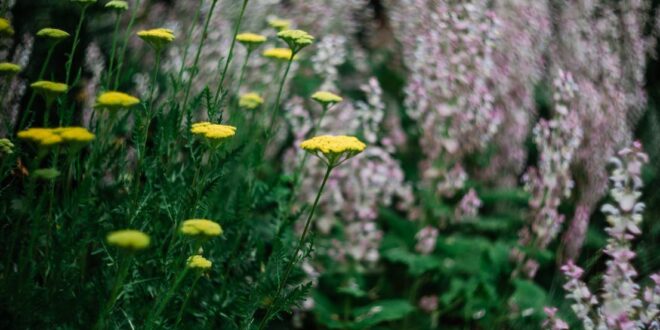Achillea millefolium – it’s a bit of a mouthful, especially as many of us, in our youth, knew it simply as ‘yarrow,’ a rather nasty-smelling, whitish-grey, flowering weed that inhabited roadsides and wasteland. If it ever happened to arrive in our parents’ garden, it was cursed for being so deep-rooted, and was quickly dug out. But a lot has changed since then, and now, ‘yarrow’ is queen of the garden. To find more about this plant’s magical transformation, and where you can use it in your garden, read on!
Naturally
While the original yarrow (Achillea millefolium) was never going to be a flower worth writing home about, it did, occasionally, throw up pinkish (quite pink, at times) blooms. It was this ability that stirred an interest in plant breeders to make something more of this humble weed. Slowly, by crossing Achillea millefolium with Egyptian Achillea (A. Taygetea), and breeding pink with pink forms, they encouraged deeper colours to develop, and now we have a wide range of hues from yellow and gold, to amber, red, salmon, and bi-coloured varieties.
Much-loved
Achillea, in its many colours, has become a much-loved plant in our summer gardens. It stands alone as a cameo of brightness in a cottage garden setting, looks spectacular in a massed planting, fits into rock gardens or wildflower fields, and dominates mid-height blooms in a perennial border. It’s silver grey foliage is a perfect foil for its bright and pastel shaded flowers. Achillea also produces a long-lasting flower (making it perfect for use in bouquets and vases), and doubles as a keeper because it can be dried and used in winter arrangements. Best of all, this obliging plant will flower right through spring and into autumn, and its umbrella-like flowers are a magnet for butterflies and beneficial insects.
Easy-osy
Achillea is super-obliging when it comes to care (no doubt due to its humble origins). Both frost and drought tolerant, it is happy to grow in poor (including sandy) soils. It enjoys full sun, but will also tolerate partial shade. And it is on the list of ‘rabbit resistant’ plants (although it always pays to take such claims with a grain of salt!).
Growth can be significant over summer, and some Achillea have a habit of ‘flopping,’ especially when the weather is wet. If you live in a part of the country where summer growth can be rampant, it is a good idea to cage your plants before they tumble. In order to keep your Achillea flowering as long as possible, cut back spent blooms (but don’t forget to leave some heads on towards the end of the season if you want to collect seed from them).
On your guard!
Achillea may be hardy, but they still suffer from occasional problems. Aphids are happy to feed off them (so keep your soap and water spray handy), and powdery mildew can settle in if you are unlucky (to deal with it, try spraying with water in which kelp has been steeped). Rust can be a problem (try the kelp water, again), and occasionally bacteria will set up home in the root region (in which case the plant may have to be removed).
Divide and rule
At the end of autumn, those in cold parts of the country may notice their plants all but disappear, as they hunker down against the coming chill. In warmer regions, foliage will be subdued but may still be present. If you feel your Achillea have grown to occupy too large a part of your garden, simply dig up the clump (in winter in warmer regions, and in spring in cooler parts), and divide it up using a spade or trowel. Friends and family will be more than happy to take the pieces off your hands.
Achillea are in vogue, right now, so if you like the look of them, and want these stunning, easy-care plants for your garden, you will have a wide range of colours to choose from!










Join the Discussion
Type out your comment here:
You must be logged in to post a comment.